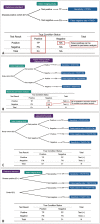Use of "Diagnostic Yield" in Imaging Research Reports: Results from Articles Published in Two General Radiology Journals
- PMID: 36447417
- PMCID: PMC9747267
- DOI: 10.3348/kjr.2022.0741
Use of "Diagnostic Yield" in Imaging Research Reports: Results from Articles Published in Two General Radiology Journals
Abstract
Objective: "Diagnostic yield," also referred to as the detection rate, is a parameter positioned between diagnostic accuracy and diagnosis-related patient outcomes in research studies that assess diagnostic tests. Unfamiliarity with the term may lead to incorrect usage and delivery of information. Herein, we evaluate the level of proper use of the term "diagnostic yield" and its related parameters in articles published in Radiology and Korean Journal of Radiology (KJR).
Materials and methods: Potentially relevant articles published since 2012 in these journals were identified using MEDLINE and PubMed Central databases. The initial search yielded 239 articles. We evaluated whether the correct definition and study setting of "diagnostic yield" or "detection rate" were used and whether the articles also reported companion parameters for false-positive results. We calculated the proportion of articles that correctly used these parameters and evaluated whether the proportion increased with time (2012-2016 vs. 2017-2022).
Results: Among 39 eligible articles (19 from Radiology and 20 from KJR), 17 (43.6%; 11 from Radiology and 6 from KJR) correctly defined "diagnostic yield" or "detection rate." The remaining 22 articles used "diagnostic yield" or "detection rate" with incorrect meanings such as "diagnostic performance" or "sensitivity." The proportion of correctly used diagnostic terms was higher in the studies published in Radiology than in those published in KJR (57.9% vs. 30.0%). The proportion improved with time in Radiology (33.3% vs. 80.0%), whereas no improvement was observed in KJR over time (33.3% vs. 27.3%). The proportion of studies reporting companion parameters was similar between journals (72.7% vs. 66.7%), and no considerable improvement was observed over time.
Conclusion: Overall, a minority of articles accurately used "diagnostic yield" or "detection rate." Incorrect usage of the terms was more frequent without improvement over time in KJR than in Radiology. Therefore, improvements are required in the use and reporting of these parameters.
Keywords: Detection rate; Diagnostic yield; False referral rate.
Copyright © 2022 The Korean Society of Radiology.
Conflict of interest statement
Chong Hyun Suh who is on the editorial board of the
Figures




Similar articles
-
Age of Data in Contemporary Research Articles Published in Representative General Radiology Journals.Korean J Radiol. 2018 Nov-Dec;19(6):1172-1178. doi: 10.3348/kjr.2018.19.6.1172. Epub 2018 Oct 18. Korean J Radiol. 2018. PMID: 30386148 Free PMC article.
-
Where do radiologists publish their work? A comparative analysis of publications by radiologists in nonradiology journals in 2000 and 2010.AJR Am J Roentgenol. 2013 Jun;200(6):W560-5. doi: 10.2214/AJR.12.10043. AJR Am J Roentgenol. 2013. PMID: 23701085
-
Presentation of Original Research at the European Congress of Radiology 2010: Frequency of Publication in Medline-Indexed Journals Within 5 Years After Presentation.Rofo. 2018 Apr;190(4):327-333. doi: 10.1055/s-0043-123473. Epub 2018 Mar 7. Rofo. 2018. PMID: 29514382 English.
-
Systematic Review of Transgender-Related Research in Radiology Over a Decade: There Is Work to Be Done.J Am Coll Radiol. 2021 Jan;18(1 Pt A):93-102. doi: 10.1016/j.jacr.2020.09.019. Epub 2020 Sep 30. J Am Coll Radiol. 2021. PMID: 33007310
-
A review of contrast media research in 1999-2000.Invest Radiol. 2001 Feb;36(2):123-30. doi: 10.1097/00004424-200102000-00010. Invest Radiol. 2001. PMID: 11224761 Review.
Cited by
-
Hospitalist-performed skin biopsy in the diagnosis of skin disease.Arch Dermatol Res. 2024 Nov 14;317(1):18. doi: 10.1007/s00403-024-03536-6. Arch Dermatol Res. 2024. PMID: 39542924
-
Enhancing local recurrence detection in patients with high-grade soft tissue sarcoma: value of short-term Ultrasonography added to post-operative MRI surveillance.Cancer Imaging. 2024 Jan 19;24(1):12. doi: 10.1186/s40644-023-00645-9. Cancer Imaging. 2024. PMID: 38243293 Free PMC article.
-
Detection rate of contrast-enhanced brain magnetic resonance imaging in patients with cognitive impairment.PLoS One. 2023 Aug 7;18(8):e0289638. doi: 10.1371/journal.pone.0289638. eCollection 2023. PLoS One. 2023. PMID: 37549181 Free PMC article.
-
Superior Diagnostic Yield of Core Needle Biopsy Over Fine Needle Aspiration in Diagnosing Follicular-Patterned Neoplasms: A Multicenter Study Focusing on Bethesda IV Results.Korean J Radiol. 2025 Jun;26(6):604-615. doi: 10.3348/kjr.2024.1022. Epub 2025 Apr 17. Korean J Radiol. 2025. PMID: 40288894 Free PMC article.
-
Conceptual review of outcome metrics and measures used in clinical evaluation of artificial intelligence in radiology.Radiol Med. 2024 Nov;129(11):1644-1655. doi: 10.1007/s11547-024-01886-9. Epub 2024 Sep 3. Radiol Med. 2024. PMID: 39225919 Review.
References
-
- Weinstein S, Obuchowski NA, Lieber ML. Clinical evaluation of diagnostic tests. AJR Am J Roentgenol. 2005;184:14–19. - PubMed
-
- Hopewell S, Clarke M, Higgins JPT. Cochrane methods. Cochrane Database Syst Rev. 2011;1:1–40.
-
- Hulley SB, Cummings SR, Browner WS, Grady DG, Newman TB. Designing clinical research. 4th ed. Philadelphia, PA: Lippincott Williams and Wilkins; 2013.
Publication types
MeSH terms
LinkOut - more resources
Full Text Sources

